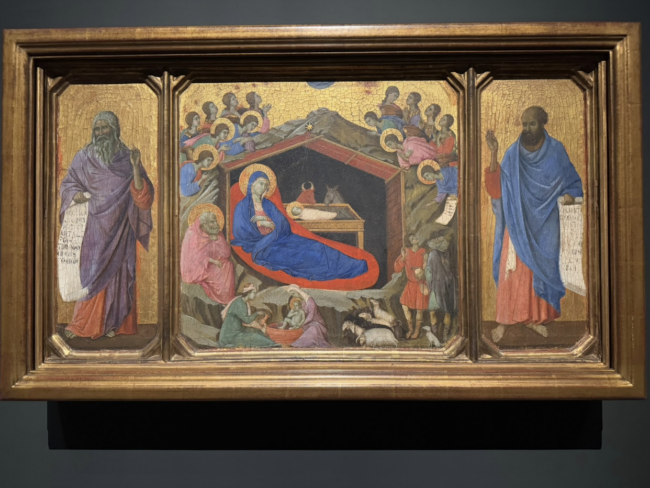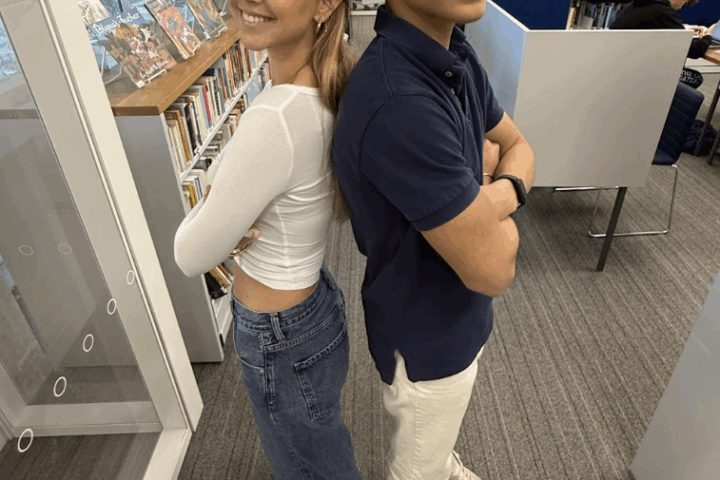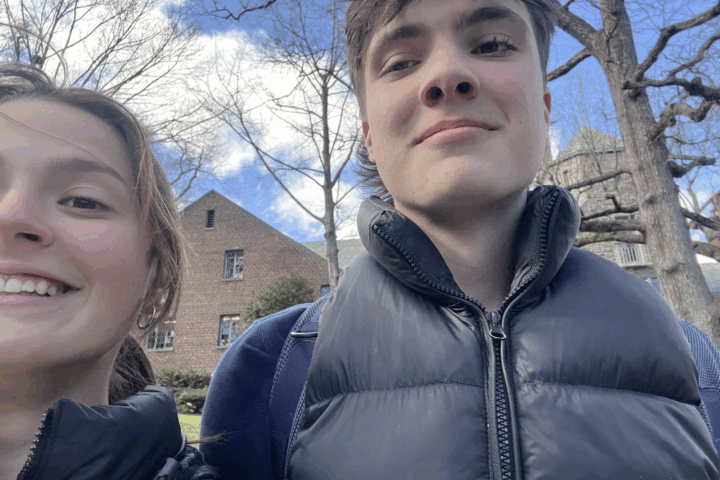Unless otherwise noted, all images are credited to Sarah Damon
When considering the great cities of art in Italy, names like Florence, Venice, Rome or Milan often come to mind. However, during the early Renaissance, the lesser-known Tuscan city of Siena played a pivotal role in defining Western painting.
Seeking to rectify this historical oversight, The Metropolitan Museum of Art in New York recently hosted an exhibition titled “Siena: The Rise of Painting, 1300-1350.” The exhibition ran from October 23, 2024, to January 26, 2025. Curated by Stephan Wolohojian, Head of European Paintings at The Met, the show reunited works that haven’t appeared together in over five centuries. Following its tenure at The Met, “The Rise of Painting” traveled to the National Gallery in London, where it will remain on view until June 22, 2025.
The Met’s exhibition immediately transports visitors into Siena’s world of gilded panels, beautiful tempera paintings and intricate marble sculptures. More than just displaying artwork, the show’s design tells a story. “The exhibition at The Met was truly a once-in-a-lifetime show where so much work from a specific time period and place were brought together in New York through loan agreements and relationships between different museums and cultural institutions. The exhibition illuminated not just the artwork but the large cultural influences that impacted the creative output at the time,” says Visual Arts Department Chair Scott Wolfson.
The first gallery sets the scene. A small 13th century “Madonna and Child” by Duccio di Buoninsegna –– the artist widely credited for ushering Sienese painting into a new era –– is flanked by two strikingly different depictions of the Virgin. To one side stands a Byzantine icon from the East; to the other, a carved ivory Madonna from Gothic France. This juxtaposition illustrates Siena’s role as a crossroad between the Byzantine world and the Gothic style of Northern Europe that still remains immensely rooted in religious devotion. Sienese art synthesizes influences from multiple areas, yet becomes something altogether unique –– distinctive, reverent and transcendent.
Siena’s geography primed it to be an artistic crucible. While it is not a port or a river city like Venice or Florence, it lies along the Via Francigena (the “French Route”)– a major pilgrimage and trade artery that connected Northern Europe with Rome and Naples. Siena’s cultural and economic vitality was nurtured through exchange and the patronage of civic and religious institutions. The influx of travelers and merchants brought with them exotic goods and aesthetic ideas. Wolfson notes, “Seeing actual textiles from Iran, Turkey, and Spain that Sienese artists would have been aware of and then seeing their painted representation side by side reinforced and illuminated the global context in which these artists were working and thinking.”
Siena’s identity in the 13th and 14th centuries was inextricably bound to the Virgin Mary. On the eve of the Battle of Montaperti in 1260, the people of Siena gathered in their cathedral to consecrate the city to the Virgin Mary and pray for victory over the superior forces of their rival, Florence. After their unlikely win, the citizens proclaimed the Virgin as its official patron –– a status affirmed in documents, annual rituals and even the city’s coinage, which bore the inscription “Sena vetus civitas Virginis” (“Ancient Siena, city of the Virgin”). The depth of this veneration vividly permeates through the art of the period, where Christian and Marian imagery is present in virtually every piece.
At the heart of Siena’s artistic revolution and the exhibition were four crucial figures: Duccio di Buoninsegna, Simone Martini and the Lorenzetti brothers, Ambrogio and Pietro.
Duccio is often heralded as the father of Sienese painting. In around 1311, he completed his most celebrated work, the Maestà. This monumental double-sided altarpiece, commissioned for the high altar of Siena Cathedral, was unprecedented in scale and marked a turning point in Western art. Duccio’s incorporation of human emotion, spatial complexity, and narrative clarity introduced innovations that would later define the Renaissance. Upon its completion, the Maestà was paraded through the streets of Siena in a grand procession, and was extremely significant to the city. The crisp outlines, delicate expressions and golden luminosity found in Duccio’s art became the hallmarks of the Sienese style. As the founder of the Sienese school, his –– as The Met describes –– “profound influence on a new generation of painters,” is evident in nearly every gallery and extends to subsequent generations of artists in the city.
Source: Wikipedia
One such successor was Simone Martini, a presumed pupil of Duccio. His Orsini Polyptych, painted for a papal cardinal in Avignon, showcases his sophisticated use of gold leaf and narrative composition. This masterpiece, along with several others in the final sections of the exhibition, illustrates how Siena’s artistic innovations spread far beyond its city walls. A true international celebrity in his time, Martini played a significant role in the development of the International Gothic style that swept through Europe in years to come.
The Lorenzetti brothers, Ambrogio and Pietro, who are also believed to be among Duccio’s students, were instrumental in advancing Sienese art towards naturalism and the early use of perspective or spatial depth. Pietro’s Tarlati Polyptych, finished in around 1320 for the church of Santa Maria della Pieve in Arezzo, exemplifies his ability to convey profound religious themes with intricate detail and vibrant use of color. On the other hand, Ambrogio’s frescoes in Siena’s city hall are acclaimed as the first true landscape and genre paintings since antiquity. He also made a move towards portraying humanity in religious art; for example, he depicted a nursing Virgin, reflecting a broader shift toward realism.
None of the four artists lived past 1350, all falling victim to the Black Death that would ravage Siena in the mid-14th century. Yet as the show poignantly notes, their achievements “had an immeasurable impact on painters and theorists in the centuries that followed.”
While the plague tragically cut short Siena’s half-century of creative brilliance, Florence soon ascended as the epicenter of the Italian Renaissance. “Wealthy families such as the Medicis in Florence played a huge role in politics and the patronage of art,” explains Wolfson, “Supporting some of the largest, most influential artworks of the time not only enhanced their own power but also the perceived strength and power of Florence, and in turn the influence of the individual artists working at the time.” Florence produced its own litter of iconic artists like Brunelleschi, Donatello, and Masaccio. Aspiring artists would flock to the city in hopes of making a name for themselves and securing commissions from the Medicis or other affluent patrons. Wolfson says, “Florence became the center of economic prosperity, artistic development, intellectual scholarship and a renewed interest in humanism.” A few years ago, former Fieldston News Editor-in-Chief Sophia Guiterrez covered another exhibition held at The Met on the Medicis and Florence for those who are further interested.
Reflecting on the Siena exhibition as a whole, Wolfson shares, “It was so amazing for me to see many artworks I had never seen before or hadn’t seen in many, many years in person and up close after reading and thinking about them for so long.” He continues, “There is nothing like seeing artwork in person — the colors, the details, the textures, all come to life and spark the imagination and understanding in a whole new way. The artwork was incredible and the scholarship was fascinating. A mindblowing show all around.”
Though Siena’s legacy is often eclipsed by its more famous neighbors, “Siena: The Rise of Painting” will continue to reaffirm the city’s status as an essential, albeit overlooked, pillar of the early Renaissance in London. The exhibition challenges the Florentine-centric narrative surrounding the Renaissance, reminding us that the movement did not emerge from a single place or at a single moment.
We come away with a newfound appreciation for how a relatively small city, fueled by faith, civic pride and a convergence of international influences, ignited centuries worth of extraordinary artistic genius.






